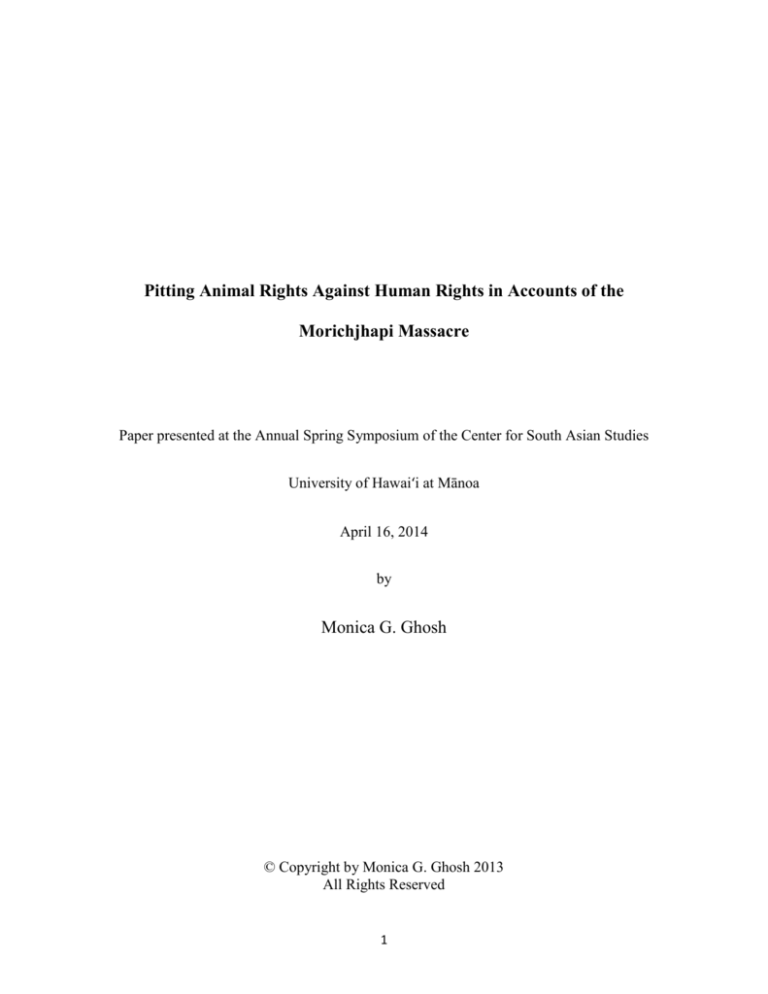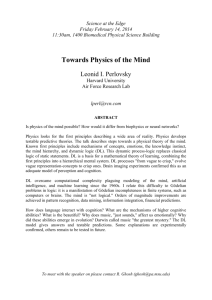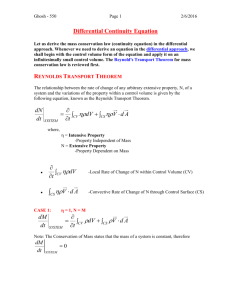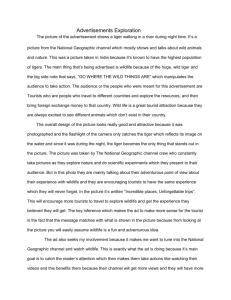
Pitting Animal Rights Against Human Rights in Accounts of the
Morichjhapi Massacre
Paper presented at the Annual Spring Symposium of the Center for South Asian Studies
University of Hawaiʻi at Mānoa
April 16, 2014
by
Monica G. Ghosh
© Copyright by Monica G. Ghosh 2013
All Rights Reserved
1
Pitting Animal Rights Against Human Rights in Accounts of the Morichjhapi
Massacre
“One can look at history from two sides and divide it into the history of nature
and the history of men. The two sides are, however, inseparable; the history of
nature and the history of men are dependent on each other so long as men exist.”
Karl Marx, The German Ideology (earlier form)
This paper recalls an event, and its literary re-narration by Amitav Ghosh in The Hungry
Tide, to explore ways in which issues related to animal “conservation” and the rights of
undocumented peoples are set in tension or mobilized against each other, resulting in
progressive cycles of violence. The “event” reveals the flexible and durable meanings of
the tiger, as well as the ways in which the tiger’s materiality and iconic significances
continue to haunt mobile, “post-colonial” images of South Asia and South Asians.
Significantly for this paper, crucial scenes from a text-within-a text (a diary) in Ghosh’s
novel take place in “a part of the Sundarbans reserved for tiger conservation” (98), which
had formerly been a site of a massacre of Bangladeshi refugees as well.
In locating his text within a traumatic and historically neglected site—simultaneously
related to conservation and human destruction—Ghosh connects tigers to movements
within and outside India. Simultaneously, he invites readers to compare and interrogate
kinds of conservation, related to the survival of endangered beings, histories, cultures,
traditions, and languages. This is amplified in contexts where people move and, in a
region seasonally flooded, where the land itself might be seen as perpetually in flux. The
background inundates the foreground and then recedes, like the hungry tides of history.
2
The very “grounds” on which movements take place are explicitly at issue in Ghosh’s
controlling metaphors. As Divya Anand has argued, Ghosh focuses on water as an “agent
of change in the struggle between human and animals for survival,” at once bringing into
relief “the plight of the dispossessed and threatened wildlife.”
Like Rabindranath Tagore and Satyajit Ray before him, Ghosh delves into the complexity
of South Asian relationships with the colonial past, while directing attention to the
uncertain future of the environment, upon which all relationships are ultimately
grounded. In doing so, he enacts Dipesh Chakrabarty’s claim that, “European thought is
at once both indispensable and inadequate in helping us to think through the experiences
of political modernity in non-Western nations, and provincializing Europe becomes the
task of exploring this thought” (16). Postcolonial writers borrow literary genres and
languages from the colonizer, but open and turn the forms toward vernacular or
indigenous storytelling and knowledge. Ghosh centers indigenous agencies and points of
view, so that the European view recedes to where “other forms of knowledge and
aesthetics, ones [colonial institutions] habitually dismissed as stunted, actually hold
powerful counter-perspectives to their own” (Mukherjee 129).
*
*
*
The psychic trauma of division on sub-continental South Asians has been commented on
by Ashis Nandy and Urvashi Batalia, who suggest that Partition figures pervasively in
South Asian narratives, whether overtly in Partition narratives or subliminally in postPartition narrative. However, Post-Partition refugees (before and after the 1971 war of
independence) from Bangladesh in India have experienced discrimination and violence
3
related to and yet outside the Nandy - Batalia paradigm. Ghosh foregrounds the impact of
Partitions throughout The Hungry Tide, and intertwines characters with perspectives
clearly influenced by different systems of knowledge. In The Hungry Tide, the character
Nirmal is the idealistic would-be revolutionary builder of schools and hospitals for the
needy, a refugee to India following the Partition of Bengal in 1947, who is dead and
“lives” through his journal entries. His wife, Nilima, is the post-independent “sober
realist” whose views on tigers represent the colonized mind. Piya represents the
ecologically righteous assimilated diasporic. Kusum, Horen, and Fokir are “native” nonWestern educated people who live and work by and on the waters of the Sunderbans and
represent the “recent refugees”; finally, Kanai functions as the omniscient narrator of all
that transpires between the characters, through his educated, upper-class, urban Kolkatta
perspective (Cottier Bucher 130).
*
*
*
The Hungry Tide is a novel in two parts, “The Ebb/Bhata” and “The Flood/Jowar.” It
starts with a map of the area in which the action takes place—the Ganges delta—that runs
across Bengal in India and Bangladesh, although the action takes place mainly in Bengal.
The protagonist Kanai is at a “south Kolkata commuter train station, waiting for a train to
Canning” (3) when he notices Piya, who “despite her silver ear stud and the tint of her
skin . . . was not Indian, except by descent” (3) —a South Asian disaporic, who does not
know Bengali. On the train journey to Canning,1 Piya manages to get a seat opposite
1
Formerly Port Canning, named after a Viceroy. In building the port the imperial
government failed to understand the local environmental systems—in this case the
periodic cyclones of Gangetic Bengal. Thus the city was destroyed in the great storms
and floods of 1867. Henry Piddington, an amateur meteorologist, warned against the
4
Kanai, spills her chai on him and her apology leads to a conversation through which we
learn that Kanai is a “translator” and “interpreter . . . by profession” (9), and Piya a
cetologist from Seattle who is “hoping to wangle a permit to do a survey of the marine
mammals of the Sunderbans” (10) to which Kanai responds with, “[R]eally? All we ever
hear about is the tigers and the crocodiles” (10). Ghosh juxtaposes the declining tiger and
indo-gangetic dolphin populations for effect: Piya works on the preservation of a dolphin
species, and by extension tigers, although the exigencies governing protective measures
are markedly different.
Morichjhapi Massacre
As soon as Kanai is comfortably seated he reads “a few sheets of paper in closely written
Bengali script”—the translation is part of his uncle Nirmal’s writings begun on “May 15,
1979. In a place called Morichjhapi” (98).2 This site was at once “reserved for tiger
conservation” (98) and a place that thousands of refugees from Bangladesh occupied in
1978. “[M]ost of them were Dalits” (99), and the communist government of West
Bengal, under the leadership of Jyoti Basu, claiming “Morichjhapi was a forest reserve,”
forcibly evicted and relocated the refugees. In the process, the government massacred an
untold number of people, including women and children; authorities later hid behind the
design of the Port. Mukherjee parallels the disastrous planning with the Morichjhapi
massacre (Mukherjee123).
মরিচঝ াঁরি this is the Bengali text of the place, which is transliterated as Morichjhapi by
Ghosh and as Marichjhapi by Mukherjee. I follow Ghosh’s transliteration, as it more
closely represents the sound by a Bengali speaker, but use the other spelling when
quoting directly by Mukherjee and/or others who may use the other form of
transliteration.
2
5
fact that there were scant records on the pre-massacre numbers of residents of
Morichjhapi, falsifying and suppressing the extent of “collateral damage” for decades.
Twenty years later, in 1999, Ross Mallick uncovered details of the massacre, which Annu
Jalais disseminated in an article in the Economic and Political Weekly (2005), presenting
the victims of the massacre as pitted against “[T]igers, in whose name the massacre of
Morichjhapi was committed” (Mukherjee 111). Environmental critic, Ramachandra
Guha, has called this false opposition of humans and animals “the paradox of global
environmentalism”: often conservation efforts mask and exacerbate problems. The
“universalizing claims of environmentalism,” Graham Huggan argues, tend to “neglect
the specific historical, material, and political contexts of ecological concerns” (720).
Thus, Ghosh draws on Mallick’s and Jalais’s research to re-represent the implications of
the event. He shows how it pitted the existence of tigers in the wild against the rights of
multiply disenfranchised tribal and refugee communities, who had been subjected to
numerous acts of state-sponsored violence before taking refuge in an uninhabited (by
humans) place. In bringing these histories back to the public consciousness, Ghosh
opposes the state’s denial of culpability. He engages the complex relational hierarchy of
human and non-human, best expressed by Annu Jalais’s report:
Many islanders explained to me that they and tigers had lived in a sort of
idyllic relationship prior to the events of Morichjhapi. After Morichjhapi,
they said, tigers had started preying on humans. This sudden development
of their man-eating trait was believed to have been caused by two factors.
One was the defiling of the Sunderban forest due to government violence,
the second was because of the stress which had been put thereafter on the
6
superiority of tigers in relation to the inhabitants of the Sunderbans. (1758)
In the neocolonial era, the Sunderbans exemplifies a process in which, as Mukherjee
argues, ‘conservation’ and ‘development’ work have produced a drastically impoverished
environment where humans and non-humans must engage in deadly competition in order
to survive” (Mukherjee 112), local people are stripped of rights, criminalized, or subject
to arbitrary displacements as a bizarre outcome of global conservation efforts that ignore
those on the ground. The refugees in Morichjhapi claim that they “had added to the
island’s potential and value by building dams, establishing small-scale fisheries, carving
out some vegetable plots and farming land” (Mukherjee 110)—a point which Nilima
takes up in the novel, ironically echoing colonial hunters in her advocacy of the primacy
of human rights over animal rights.
*
*
*
Hierarchies where humans dominate are contrived and tend to submerge local myths that
relate how humans interact and perceive of their environments. One such marvelous story
is that of Bon Bibi. According to Sufia Uddin, the story of Bonbibi3 is an important part
of the Jaharnama, which she explores in a chapter of Engaging South Asia Religions:
Boundaries, Appropriations, and Resistances. Uddin notes that shrines to Bonbibi appear
deep in the Sunderbans that represent her as “a beautiful woman, riding a tiger with a
protective arm around a much smaller human male” (61), similar to the Hindu goddesses
Durga and Lakshmi. She is venerated by both Hindus and Muslims, is said to “provide
3
Uddin does not separate the name of Bonbibi into two words, as does Ghosh (Bon Bibi).
I follow the form of the writer as it represents their respective usage.
7
protection to honey collectors, wood cutters, and others whose livelihood is dependent on
this forest,” and “provides boons to those who recognize her power” (61), regardless of
their religious affiliation. Her origins are Arab (Uddin 69), from Mecca, but significantly,
Uddin notes, “the Jaharnama is a uniquely Bengali story—more precisely a Sundarbans
story . . . the Bonbibi myth provides a story of the beginnings and establishment of
community in the Sunderbans” (70). Ghosh intertwines the lives of the characters with
their beliefs and stories about tigers and dolphins that have their origins in the
Jaharnama. Most importantly, in his text tiger references draw on both indigenous
perspectives and colonial ones that intersect or inform each other.
In the novel, the Bon Bibi story is revealed through Kusum’s story about how her father
was caught in a storm and “saved” by Bon Bibi “and her brother Shah Jongoli” (185).4
Bon Bibi appears to Kusum’s father in the form of a tiger and advises him in a “dream”
not to be afraid. She, Bonbibi, assures him that “[T]his place you’ve come to, I value it as
my own; if you’re good at heart, here you’ll never be alone.” Then she guides him out at
low tide with her “messengers, my eyes and ears,” that appear accompanied by “a sound
like a man blowing his nose . . . black skin disappearing into the water . . . a glimpse of a
black triangular fin” (193-194). The triangular relationship—a goddess who is
interchangeable with the form of a tiger, her messengers the river dolphins, and
humans—is strategic on Ghosh’s part to excavate and activate pre-colonial stories that
connect land, sea, and nature and that depict an environmental indigenous epistemology
4
Bonbibi combines the words for sister (bon) and wife (bibi), and Shah Jongli translates
to Jungle King.
8
in which humans are not always “at the top of the food chain.”5
Bon Bibi does not have to appear to provide protection from fear – chants and offerings
work equally well. Much later in the novel, approaching Garjontola by boat, Horen asks
Kanai “bhoi ta ter paisen?” Kanai responds, “Why should I be afraid?” Horen advises
him that “fear . . . protects you . . . it’s what keeps you alive. Without it the danger
doubles.” Next Horen mumbles and gesticulates with his hands prompting Kanai to
question Kusum for an explanation of Horen’s actions. She replies “[H]e is a bauley. He
knows the mantras that shut the mouths of the big cats. He knows how to keep them from
attacking us.” Kanai is not convinced that Horen can “shut the mouth of a tiger,” but the
chanting “reassures” him (203). The purpose of the trip was to return to the shrine for
Bon Bibi that Horen’s father had built after she “saved” him from “the tiger demon
Dokkhin Rai” and to “place the images of Bon Bibi and Shah Jongoli” there, followed by
a hybridized puja using “Arabic invocations” for Bon Bibi and Shah Jongoli that Horen
says he had known “as long as I can remember. I heard my father reciting it, and I learned
from him” (204). Thus, Ghosh’s extended reference to the legend of Bon Bibi, Samrat
Laskar contends is in “direct contravention to the colonial practice of translating select
Oriental texts that conform[ed] to their idea of the Orient.” By invoking this legend
Ghosh “resuscitates the culture of the subaltern indigenes instead of exoticizing it.”
*
*
*
Ghosh juxtaposes the indigenous system with the more familiar one that duplicates
5
This quote is from David Quammen’s Monsters of God, which I refer to in my
dissertation titled Tiger Files: Textual and Visual Representations of Tigers in South Asia
Contexts.
9
colonial hunting narratives, which is rife with anxiety. When Kanai tells Nilima that he
will accompany Piya on a research expedition on the river and into the forest, she
responds:
“Kanai...this is not a joke. I know that in this day and age, in the twentyfirst century, it’s difficult for you to imagine yourself being attacked by a
tiger. The trouble is that over here it’s not in the least bit out of the
ordinary. It happens several times each week.”
“As often as that?”
“Yes. More . . . Look . . . I’ve been keeping unofficial records for years
based on word-of-mouth reports. My belief is that over a hundred people
are killed by tigers here each year . . . I’m talking about the Indian part of
the Sundarbans. If you include the Bangladesh side, the figure is probably
twice that. If you put the figures together, it means that a human being is
killed by a tiger every other day in the Sundarbans – at the very least.”
“That’s the trouble . . . Nobody knows exactly how many killings there
are. None of the figures are reliable. But of this I’m sure: there are many
more deaths than the authorities admit.” (198-199)
While the figure for the tiger “killings” are not “reliable,” they in a sense don’t matter, as
Nilima is pre-committed to the “threat” tigers pose. When Kanai surmises that tiger
killings might be a “recent trend” caused by human “overpopulation . . . or encroachment
of the habitat,” Nilima claims that tiger “attacks have been going on for centuries,”
10
substantiating her statement through a colonial document: “4,218 . . . the number of
people who were killed by tigers in lower Bengal in a six-year period—between the years
1860 and 1866,” taken from “figures compiled by J. Fayrer . . . the English naturalist who
coined the phrase ‘Royal Bengal Tiger’” (199).6
Around the same time, the tiger became a “man-eating tiger,” whose rapacious desire for
human flesh was naturalized locally, exacerbating conflicts in encounters between
humans and tigers. The increased material violence of a fear atmosphere is represented in
a chapter aptly titled “Killing,” that begins with a disturbance in the village caused by the
sight of “prints . . . clearly marked as those of a kitten . . . only many times larger”— tiger
pugmarks! Following the trail leads them to a “small mud-walled structure thatched roof”
where “[M]ore than a hundred people,” mostly men had gathered “armed with sharpened
bamboo poles,” which they used to plunge “into the hut again and again.” The crowd and
their actions are horrifically rendered: “Their faces contorted in such a way that they
seemed to be in the grip of both extreme fear and uncontrollable rage. Many of the
women and children in the crowd were shrieking, ‘Maar! Maar! Kill! Kill!’” (240). The
villagers response to the trapped tiger is explained this way, “[T]he tiger was not new to
the village, it had killed two people there and had long been preying on its livestock.”
Piya is mortified by the mob violence of the villagers towards this magnificent,
endangered animal and pleads, “We have to do something, Kanai. We can’t let this
happen,” but Kanai refuses to intervene saying, “Piya, you have to understand – that
animal’s been preying on this village for years. It’s killed two people and any number of
6
Fayrer, not incidentally, published a book titled, The Royal Bengal Tiger, His Life and
Death in 1875, and another on venomous snakes of India. Both books evince his
predilection to see nature as hostile and in opposition to humans.
11
cows and goats.” To which Piya responds, “This is an animal, Kanai, you can’t take
revenge on an animal.” Piya valiantly tries to intervene, but even Fokir picks up a
bamboo pole and joins the attackers, whose spears are “stained with blood” with “black
and gold fur stuck between the splinters” (242). The crowd’s hostility turns quickly
towards her, requiring a quick retreat to the boat, from where they “smelled the reek of
burning fur and flesh.” “Fokir says you shouldn’t be upset,” Kanai translates for Piya,
who replies: “How can I not be upset? That’s the most horrifying thing I’ve ever seen – a
tiger set on fire.” To which Fokir answers, “when a tiger comes into a human settlement,
it’s because it wants to die” (244).
Arguments for the “killing” are reproduced through Piya’s ecologically righteous
viewpoint, which separates her from Fokir, whose response is informed by a mix of
indigenous beliefs and practices tied to legends of Bon Bibi and Dokken Rai and
alternating between colonial anxieties that are either unfounded or based on real dangers
and mutual hostilities. As Kanai says, “[H]e’s a fisherman – he kills animals for a living”
(248). Kanai, however, has absorbed Nilima’s colonial argument, which constructs a
false binary between disenfranchised populations and the environment. In fact, policies of
aggression and violence towards people, as in the Morichjhapi massacre, or towards
tigers, as reported in the news, require an awareness of the stories that influence our ideas
and strategies that support co-existence with respect for our natural differences—a
healthy dose of fear to “shut the big cats mouth.” Thus, tiger conservation serves as a
pretext for violence against people, who in turn retaliate against tigers, seen here as both
living beings and as figures of complex eco-poetical issues.
*
*
12
*
Ghosh’s connecting of fiction and fact both in the political and natural systems of
knowledge breaks from the web of intertextuality, colonial and/or patriarchal, to open up
possibilities for understanding and connecting to places and history in imaginative ways
that widen and deepen our consciousness at many levels to reveal the complex circulation
of ideas in postcolonial South Asia. Conflicts are clarified and resolutions projected into a
future-to-come. Ghosh captures this “defer-ence” poetically and optimistically in
comments on the Sunderbans, which touch as well on the resilience of languages that
criss-cross contemporary boundaries:
the mudbanks of the tide country are shaped not only by rivers of silt, but also by
rivers of language: Bengali, English, Arabic, Hindi, Arakanese and who knows
what else? Flowing into each other they create a proliferation of small worlds that
hang suspended in the flow . . . a meeting not just of many rivers, but a circular
roundabout people can use to pass in many directions—from country to country
and even between faiths and religions. (247)
The implications of ebbs and flows and the movements of various aspects of “life”
suggest the respect for organic processes written into the rhythms of land and history. As
Mukherjee argues, “symbiotic continuities between the human and the non-human, the
‘natural’ and the ‘cultural’ . . . register the historical process of the uneven development
and penetration of capital” (133). Such historically produced inequality suggests the need
for environmental paradigms that build on local values, stories, and expressive traditions
of relating to the extra-human world. Fiction emerges as a space of recovery and
restoration. In Ghosh’s eloquent words: “fiction . . . can help people inhabit a place—to
inhabit it in the fullness of their minds, to inhabit it with their imaginations, to see the
13
ways in which lives link together, the lives of animals, the lives of trees, the lives of
human beings.”7
7
“The Author Talks” interview with Amitav Ghosh.
14
Works Cited
Anand, Divya. "Sustainable Development and Environmental Politics: Case Studies from
India and Australia." Thesis Eleven 105.1 (2011): 12p. Print.
Chakrabarty, Dipesh. Provincializing Europe: Postcolonial Thought and Historical
Difference. Princeton Studies in Culture/Power/History. Princeton, N.J.: Princeton
University Press, 2000. Print.
Cottier Bucher, Annie Madeleine. “Settlers in the Sundarbans. The Poetry and Politics of
Humans and Nature in Amitav Ghosh's The Hungry Tide.” In On the Move. The
Journey of Refugees in New Literatures in English. (pp. 125-137). Cambridge
Scholars Publishing, Cambridge, 2012.
Ghosh, Amitav. “The Author Talks.” The Hungry Tide. Audiobook on CD. Recorded
Books, 2005.
Ghosh, Amitav. The Hungry Tide. Boston: Houghton Mifflin, 2005. Print.
Guha, Ramachandra. “The Paradox of Global Environmentalism.” Current History 99
(November 2000): 367-370.
Graham Huggan. ""Greening" Postcolonialism: Ecocritical Perspectives." MFS Modern
Fiction Studies 50.3 (2004): 701-733.
Jalais, A. (2005), ‘Dwelling on Marichjhapi’, Economic and Political Weekly, 40 (17):
1757–62.
Laskar, Samrat. “Amitav Ghosh’s ‘The Hungry Tide.’” Online at:
http://www.museindia.com/regularcontent.asp?issid=35&id=2422
Mallick, Ross. "Refugee Resettlement in Forest Reserves: West Bengal Policy Reversal
and the Marichjhapi Massacre." Journal of Asian Studies 58.1: 22p. Print.
Marx, Karl. The German Ideology.
<http://www.marxists.org/archive/marx/works/1845/germanideology/ch01a.htm>.
Mukherjee, Upamanyu Pablo. “Water/Land: Amitav Ghosh.” In Postcolonial
Environments. Basingstoke: Palgrave Macmillan, 2010. 216. Print.
Steinwand, Jonathan. “What the Whales Would Tell Us: Cetacean Communication in
Novels by Witi Ihimaera, Linda Hogan, Zakes Mda, and Amitav Ghosh.” In
Postcolonial Ecologies: Literatures of the Environment. New York: Oxford
University Press, 2011. Print.
Uddin, Sufia. “Beyond National Borders and Religious Boundaries.” In Engaging South
Asian Religions: Boundaries, Appropriations, and Resistances. Suny Series in
Hindu Studies. Albany: SUNY Press, 2011. Print.
15








